Have you run out of shelf and floor space for your indoor garden? (Gasp!) Or maybe you have chubby, inquisitive hands and curious snoots who might poke around the greenery.
There are many reasons to pick up a few hanging plants for your home.
Hanging plants include any foliage placed in hanging baskets, pots, and other containers. They’re an excellent use of vertical space and a beautiful way to add colour above your sight line.
Some of the best indoor hanging plants in Australia include:
- Spider plants
- Pothos and philodendron varieties
- Ferns like the Boston fern and bird’s nest fern
- Ivies such as English ivy
- Air plants
Here’s a round-up of indoor hanging plants – with handy sections depending on what type of hanging plants you want!
Best for Beginners | Best for Clean Air | Best for Low Light | Best Low-Maintenance | Best Hanging Succulents | Best Flowering | Best Air Plants | Unusual Plants | Honourable Mentions
Why Have Indoor Plants?
There are many reasons to keep indoor plants beyond the aesthetic. Having plants inside your home can:
- Improve air quality
- Add depth and colour
- Boost your mood and mental health
Moreover, they simply look good! Indoor plants add an elegant and natural touch to any space.
And if you have limited shelf space? Time to hang them up!
Best Indoor Hanging Plants for Beginners
If you’re a first-time gardener, some common indoor hanging plants make a great starting point.
These hanging houseplants are easy to care for – no complicated misting schedules or sunlight requirements!
1. Spider plant

This is everyone’s favourite indoor plant, and yep, you can hang it up!
The spider plant (Chlorophytum comosum) features curling leaves with variegated foliage, but the showstoppers are the long, spider-like stems that grow baby plants.
That lush growth makes the spider plant a stunner in a hanging pot. The stems can reach 0.6m in length, and can even produce white flowers under the right conditions.
Spider plants tolerate some shade, though they’ll do better in bright, indirect light.
Their tubers retain moisture so they’re drought-tolerant. Keep them in warm, humid conditions.
2. English ivy
English ivy is an old-school indoor plant that adds an elegant touch to any space. Hedera helix is one of the more popular trailing plants, especially since it’s great for beginners!
One advantage to English ivy is that it can tolerate dim or low lighting. But know that the variegation won’t be as vivid and bright as when it gets more sun.
Two important notes, though: English ivy is toxic to humans and animals, and it can be considered an invasive species. Hence, it’s best grown in a hanging basket indoors, where it’s out of reach.
3. Pothos
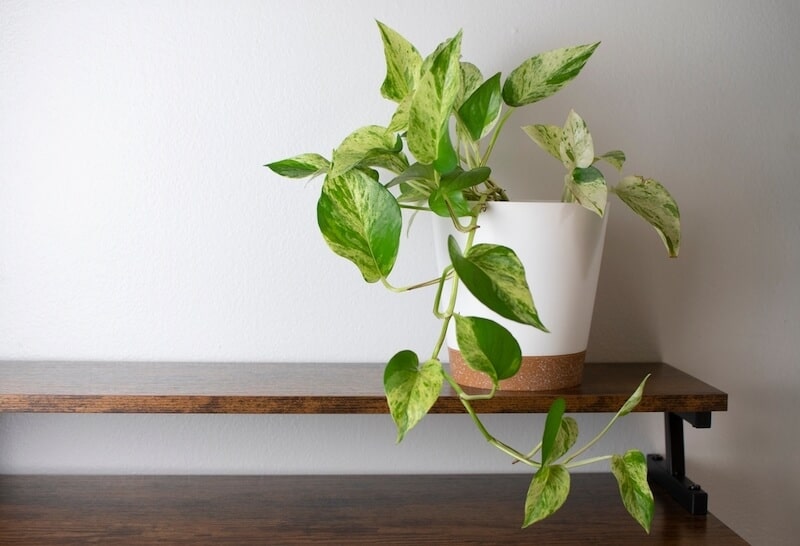
Technically, the plants we commonly call “pothos” aren’t from that plant genus. Scientists used to classify them as such, but discovered later on that they were more closely related to a different plant species.
Still, many nurseries and gardeners continue to call them pothos, and so do we!
Most pothos varieties are adaptable to all sorts of growing conditions. That makes them popular indoor hanging plants, even for those of us just starting to develop green thumbs.
Some classic pothos plants include the Golden Pothos, Marble Queen, Neon, and Snow Queen. The stems look gorgeous when left to grow and trail out of a hanging planter.
Best Indoor Hanging Plants for Clean Air
All plants are capable of recycling our exhaled CO2 into clean, breathable oxygen.
However, these indoor plants have a reputation for being particularly efficient at purifying the air.
1. Devil’s ivy
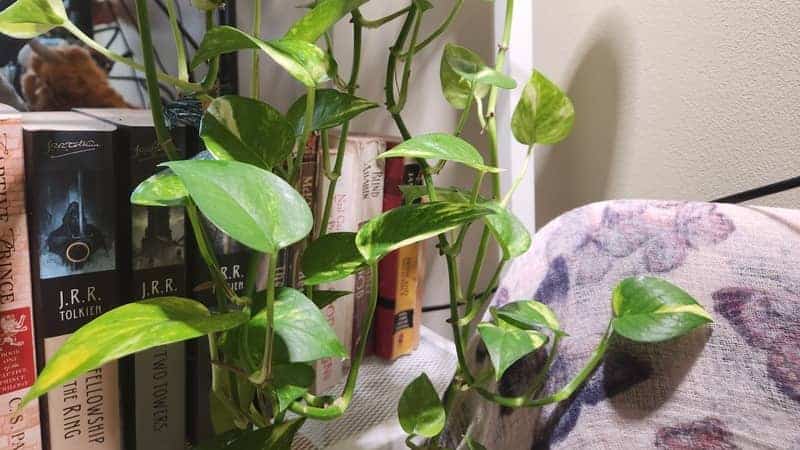
This is a specific variety of the pothos plant, popularly known as golden pothos. It gained the nickname devil’s ivy since it’s almost impossible to kill – even when kept in a dark corner!
The NASA 1989 Clean Air Study listed devil’s ivy as one of the best for removing carbon monoxide and other contaminants from indoor air.
Its heart-shaped leaves can climb up posts and stakes. However, if left unsupported, the trailing stems will trail for over a metre.
Devil’s ivy can also tolerate shade, drought, and varying temperatures.
2. Heart-leaf philodendron
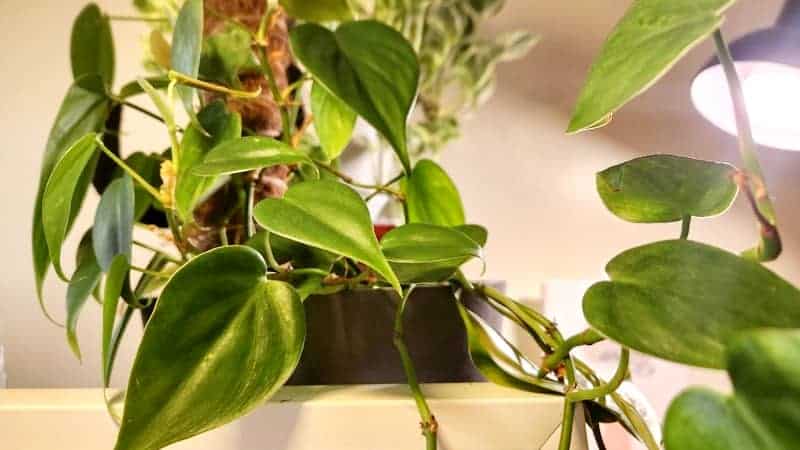
Yet another popular indoor hanging plant with heart-shaped leaves! Philodendrons resemble pothos, both in terms of foliage and ease of care.
The classic heart-leaf variety features all-green trailing vines, but the more vivid Brasil (aka the sweetheart vine) has variegation in a pale green colour.
Most philodendrons will tolerate dim conditions, but the variegation stands out more in bright light.
3. Boston fern
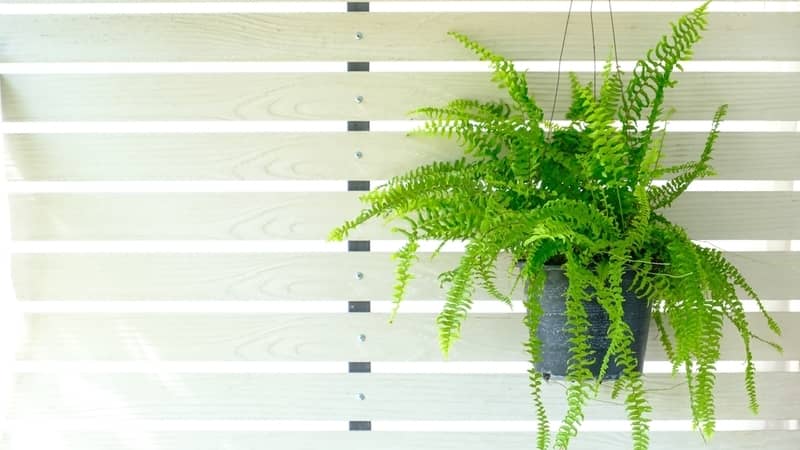
Ferns are another plant on NASA’s list of clean air plants. And the Boston fern looks like it was made to sit in hanging baskets.
This lush plant features feathery leaves that can reach about half a metre or more. However, do know that these ferns are a bit finicky.
Boston ferns require high humidity (approx. 80%) and bright, indirect light to recreate their native tropical environment. If conditions are too dry, it will shed dead leaves all over your floor.
Best Indoor Hanging Plants for Low Light
If you’re looking for the best hanging plant for a bathroom, one of these should be your go-to.
They can tolerate low light and humid conditions – although don’t keep them in the dark all the time!
1. Mistletoe cactus

It may not look like a classic Western saguaro, but Rhipsalis baccifera still falls within the cactus family.
More specifically, it’s a tropical epiphytic plant – meaning it pulls food and moisture from the air or plants it latches onto.
Instead of more traditional “leaves,” the mistletoe cactus has thin, stick-like foliage.
Unlike its flashier cousins such as the Christmas cactus, the mistletoe variety has insignificant flowers – its visual appeal lies in the trailing stems.
You can grow mistletoe cactus in low-light conditions (just know it’ll spread slower than in brighter light). It prefers slightly acidic soil that’s kept evenly moist – don’t let the soil dry completely.
2. Grape ivy
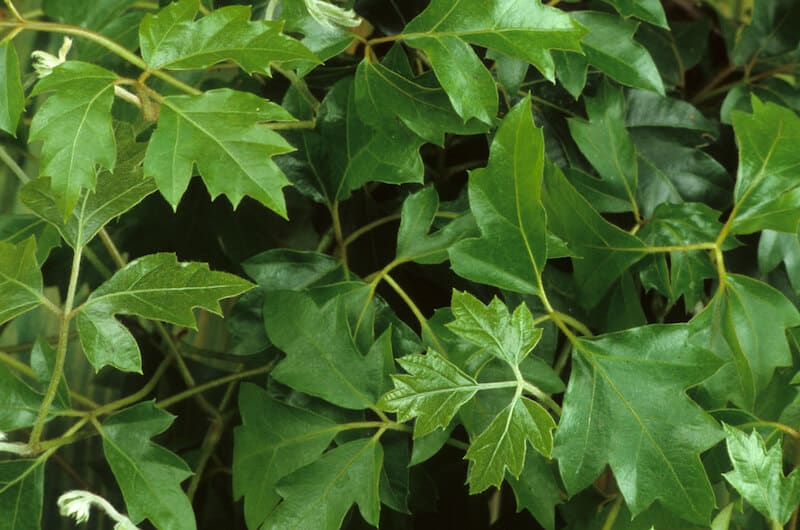
This lesser-known “ivy” has absolutely stunning leaf patterns. It’s one of the best hanging plants you can have as the vines can trail up to 3.0m long – and the foliage gets shinier as it grows!
While called “ivy,” Cissus alata is actually a vine plant. It doesn’t produce any grapes, though, but it does resemble lush grapevines.
This slow-growing plant is well-adapted to low-light conditions and can even grow under artificial lighting. Just make sure it has well-draining and consistently moist soil to keep the roots healthy.
3. Baby rubber plant
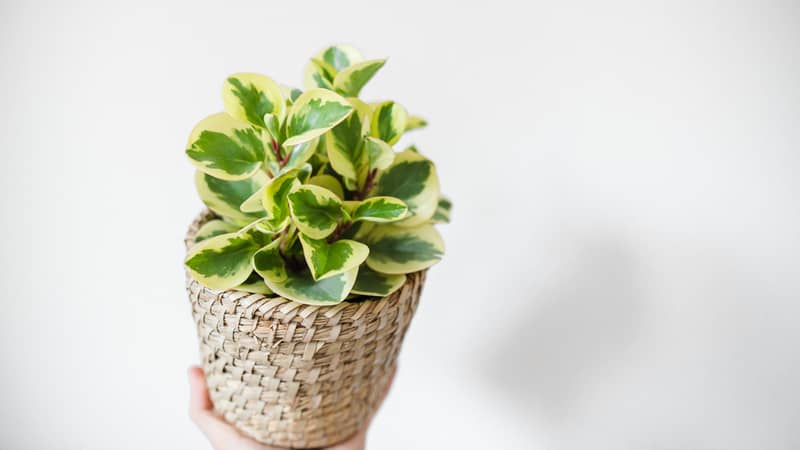
The Peperomia obtusifolia is another chill indoor houseplant. Most people prefer to keep them in pots as a climbing plant, but the stems can also hang down to act as a trailing plant.
Non-variegated cultivars can absolutely grow in low-light conditions. You’ll end up with a hanging houseplant featuring dark green leaves – adding a sophisticated accent to a room.
Baby rubber plants aren’t fussy about their potting mix, and they’re fairly drought-tolerant. However, don’t let them go too long between waterings, either!
Best Low-Maintenance Indoor Hanging Plants
If you often forget to water plants or if you’ve got a busy schedule, these will be your green and leafy best friends.
1. Tradescantia
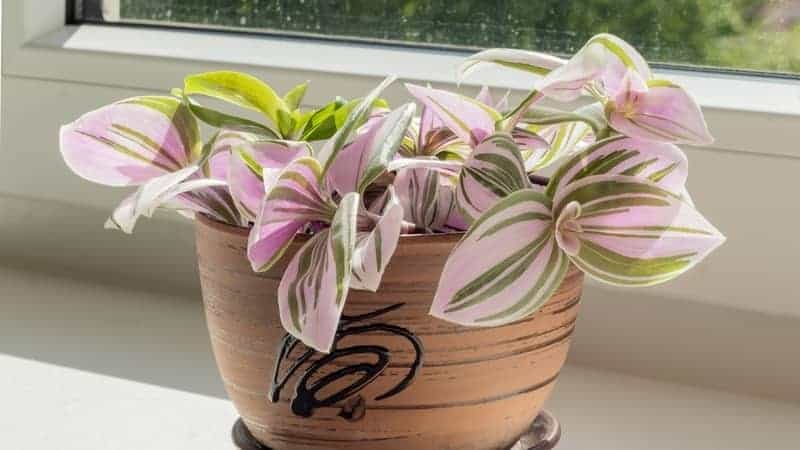
This genus covers a lot of different plants, including the wandering dude and spiderwort. Tradescantia are perennial wildflowers native to the Americas, which feature colourful foliage.
Some popular varieties have silver variegated leaves, while others are an elegant purple. The Tradescantia Nanouk even has bright purple foliage that borders on pink!
Thankfully, these plants are pretty forgiving. Simply position them somewhere with indirect lighting and moderate to high humidity.
For watering, simply poke the soil to check if the top 3.0cm is dry.
2. String of pearls
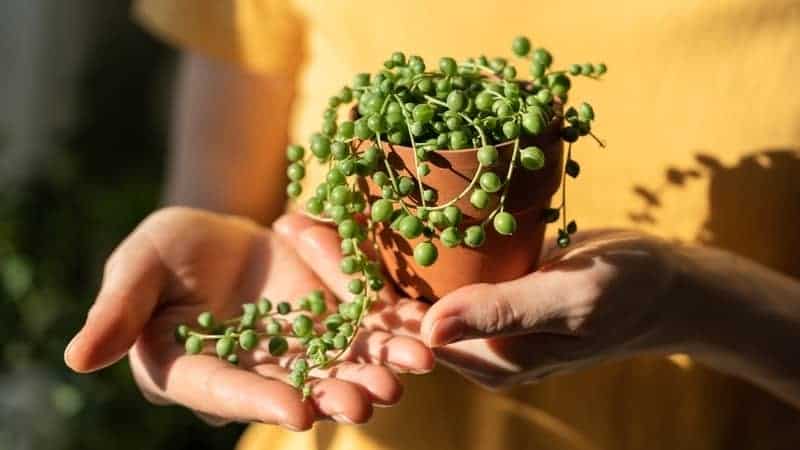
Senecio rowlyeanus is a very distinct plant due to its round, fleshy leaves. Once you see it, you’ll know exactly why it’s called the string of pearls!
Looking like a very long necklace, this succulent stores water in its plump leaves. This allows it to survive periods of drought (or periods of oops-I-forgot-to-water-the-plants-again).
The most important part of caring for a string of pearls is lighting! Place your plant in a spot where it receives several hours of bright light in the daytime. Avoid direct afternoon sun, though – that could scorch the leaves.
3. Curly orchid cactus
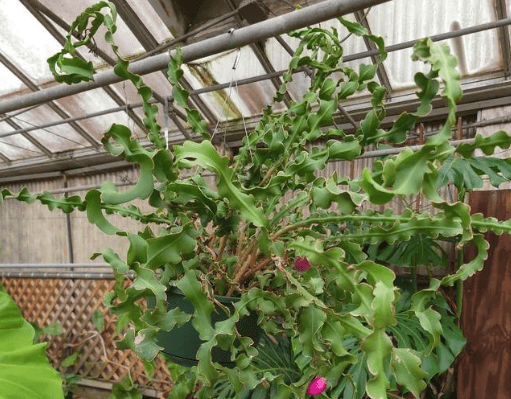
Don’t let the word “orchid” in its name put you off – the curly orchid cactus (or curly cactus, or ‘Curly Sue’) isn’t fussy in the slightest.
This epiphyllum is a jungle cactus that, in its native environment, lives in poor conditions. It can survive on moisture and nutrients from the air or other plants.
Keep your curly cactus in bright to medium light. It doesn’t like moist soil – in fact, you can let the potting soil dry out before watering again.
While it’ll be happy with household humidity, a little misting goes a long way.
Best Hanging Succulents
We often think of succulents as tabletop or shelf plants.
However, there are quite a few types that look amazing when placed in hanging baskets or pots!
1. Burro’s tail

The Sedum morganianum looks fluffy and adds a touch of quirky character to any room.
It’s one of the more unique and distinctive succulents thanks to the plump leaves cascading outwards.
Burro’s tail (or donkey’s tail) is a low-maintenance plant often found on tabletops, but it shines in a hanging planter!
The chunky stems trail outwards and downwards, although you’ll need to be careful as they can be quite fragile.
Keep your burro’s tail succulent in a sunny spot as it lights plenty of light. Allow the soil to fully dry between watering.
2. String of Hearts
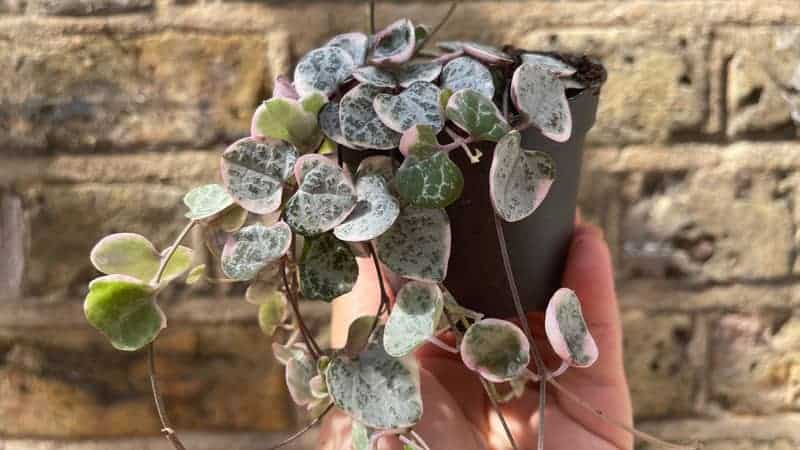
As indoor plants have become more popular, the string of hearts has become more common. The Ceropegia woodii is an evergreen vine succulent with small, apple-like silver leaves.
If left to itself, the string of hearts stems can trail well over 3.0m! The leaves remain small, but the stems tangle together to give the plant more texture.
Be careful, though – the stems are delicate.
Don’t place your string of hearts right beside a window, since direct sunlight can burn the leaves.
Let the soil dry out between watering and ensure it has well-draining cactus potting mix.
Best Flowering Hanging Plants
Flowering plants are a bit trickier to handle since they require a good amount of sunlight.
But if you get the conditions right, your indoor hanging plants will become statement pieces.
1. Orchids

We usually put orchids in vases or similar containers, but you can absolutely hang them up! Varieties like the moth orchid (Phalaenopsis) are very attractive when placed in a hanging pot.
Simply place the orchids in hanging baskets and allow the flowering stems to cascade outwards.
Keep the potting medium consistently moist (but not soggy) and make sure your orchids get enough light.
Don’t throw your orchids out once they’re done blooming! If you trim them and care for them, they’ll last you for years.
2. Christmas cactus
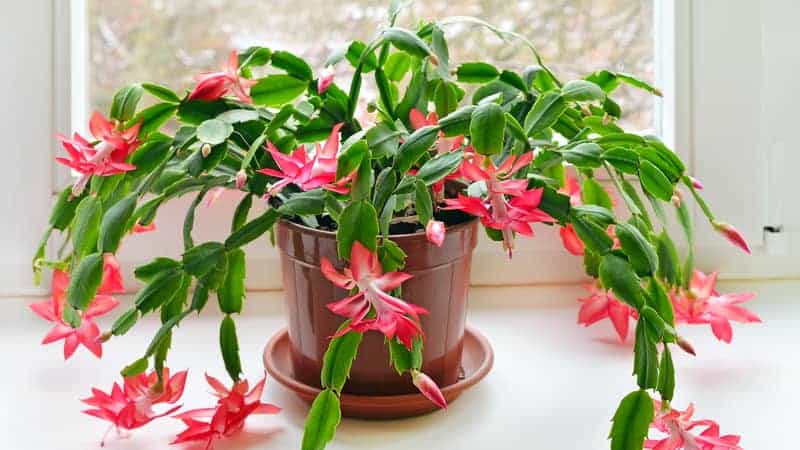
Brighten up your home in winter with this holiday favourite. The Christmas cactus blooms during the cooler months, and can re-flower year after year.
Plus, this plant is pet-friendly!
Make sure your Christmas cactus has good circulation and well-draining soil. Keep the potting medium consistently moist with moderate morning sunlight. And repot the cactus every year after flowering.
3. Queen of the Night
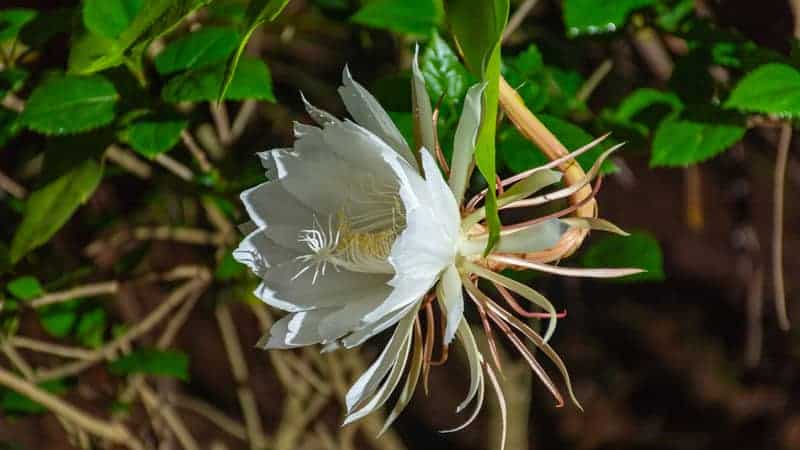
This is another flowering cactus to show off to friends and family!
As the name implies, Queen of the Night is a night-blooming cactus, and the flowers will begin wilting by dawn.
Place your Queen of the Night where it gets indirect sunlight.
As hanging plants, the leaves of these cacti will spill over the edges of the container – and so can the flower stems.
Best Air Plants for Hanging Planters
Air plants are unique in their ability to sustain themselves with limited soil.
They can take moisture and food from the air and water – just make sure they get enough sunlight!
1. Staghorn

The staghorn fern is an air plant and a fern. It resembles a deer’s antlers, giving the plant a unique and show-stopping appearance.
Many people actually mount their staghorn ferns on wooden planks on the wall as a statement piece.
Since the plants are epiphytic, they can take nutrients from the air. However, they’ll still need a base of moss or other organic matter to mimic a host plant.
Water your staghorn regularly, but let the base dry out in between. Keep them in warm, humid conditions with shaded light.
2. Tillandsia
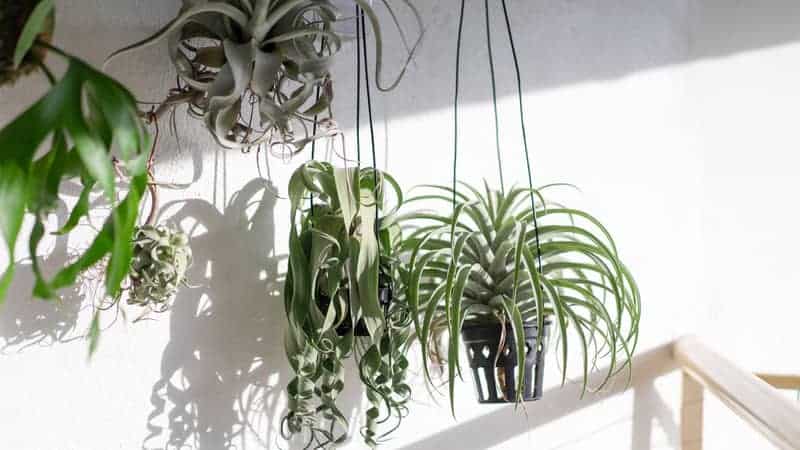
If you have really limited space, then it’s better to go for small hanging plants. Tillandsia varieties are air plants that can grow even without soil – just spritz them with water!
These air plants belong to the bromeliad family, so they take their nutrients from water and light.
Simply soak the Tillandsia roots in a little water for half an hour, then let the excess moisture dry. Try to mist them every other day to refresh the leaves.
Other than that, place your Tillandsia in bright but indirect light. If it starts budding, that’s a sure sign it’s doing great.
3. String of nickels
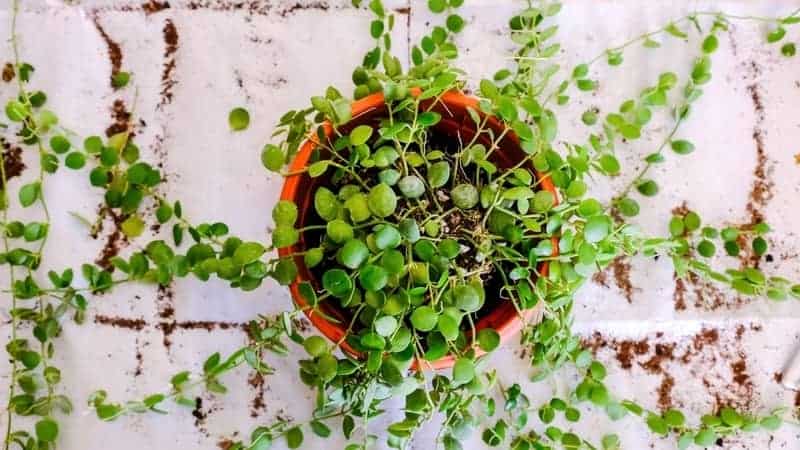
This air plant or epiphyte survives in nature by clinging to tree trunks and absorbing moisture from the air. In your home, it’s a stunning plant with trailing stems that stretch up to 3.0m.
The string of nickels features succulent-like leaves that look like their namesake coins.
It likes humid settings as a tropical plant, so keep a spray bottle handy for misting.
Keep in mind, though – the string of nickels needs a specialised medium such as orchid compost to grow!
Unusual Indoor Hanging Plants
Looking for something more unique to fill your hanging pots?
These plants may not be the first to come to mind when thinking of indoor hanging plants, but they’ll definitely fit the bill!
NOTE: You may encounter recommendations for a polka dot plant. While it can work as an indoor hanging plant, it is considered an invasive species in Australia. Check your local council regulations first!
1. Peperomia Hope
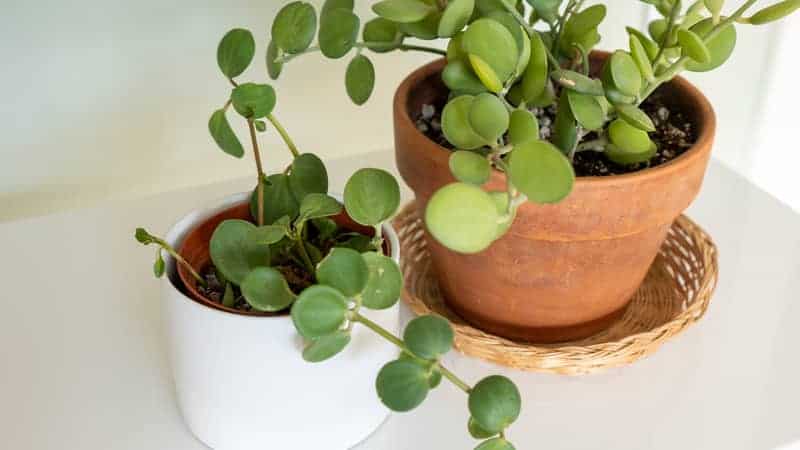
You might not think of peperomias for hanging baskets, but they absolutely can pull it off!
The “Hope” variety has thick leaves that look like succulents, growing on trailing stems.
Place your peperomia in indirect sunlight, and rotate it frequently so it grows evenly. Let the top layer of soil dry out between watering.
2. Monstera Siltepecana
Often out–shadowed by its deliciosa cousin, the Siltepecana is just as beautiful!
It has small, delicate leaves that have a silvery sheen as a juvenile plant.
If you keep the Siltepecana in a hanging planter, it’ll retain its juvenile appearance without the signature monstera fenestrations and holes.
Place it somewhere with indirect lighting and don’t keep the soil too wet.
3. Lepismium bolivianum
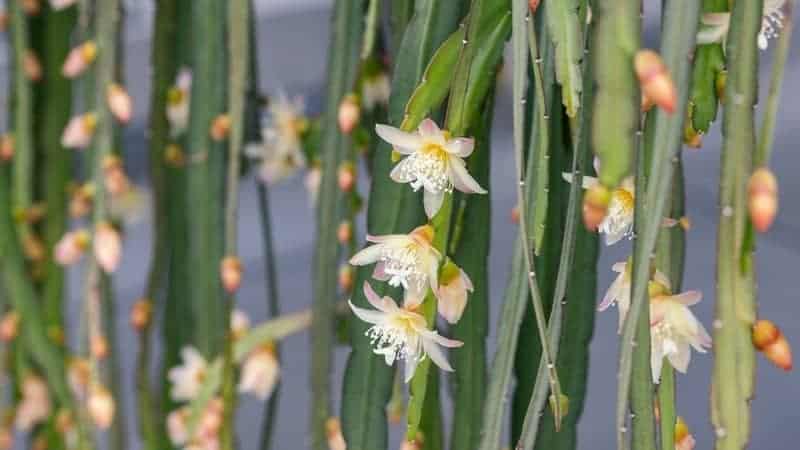
This strange, spine-free cactus makes a great conversation piece. It has flat cascading strands that can sometimes produce pink flowers.
Keep your Lepismium bolivianum in a place with low humidity – the less, the better!
Avoid direct light as this can burn the leaves.
Honourable Mentions for Hanging Indoor Plants
These are no less fantastic when displayed as hanging plants, but they are a bit picky about their growing conditions.
Make sure you’ve done your research before bringing one home.
1. Prayer plants

These distinct and gorgeous tropical plants are best known for their decorative leaves – especially the tricolour variety. The prayer plant is slow-growing but well-suited to growing indoors.
It’s important to know, though, that Maranta leuconeura isn’t easy to maintain in the long term. It requires consistent high humidity, good airflow, and regular watering.
Cultivars with variegation also need moderate light levels to keep their colour. In winter, your prayer plant will need bright light to prevent it from dying back.
2. Maidenhair fern
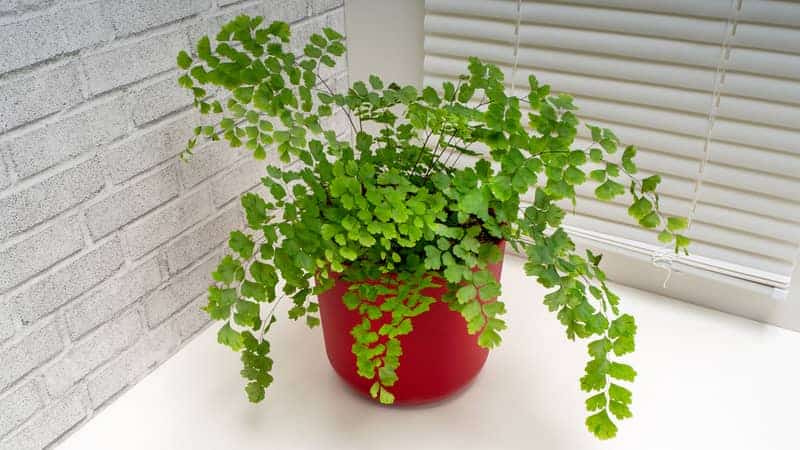
Unlike its hardier cousin from Boston (okay – not really), this is a more delicate fern. The Maidenhair fern needs bright light and high humidity to thrive.
Maidenhairs have fan-shaped leaves that grow in clusters. Besides being great as indoor hanging plants, you can also grow them on vertical surfaces such as rock walls.
If you’ve got a sunny bathroom with windows, this fern is the perfect room accent. Otherwise, keep the humidity up with a humidifier or with regular misting.
3. Wax plants
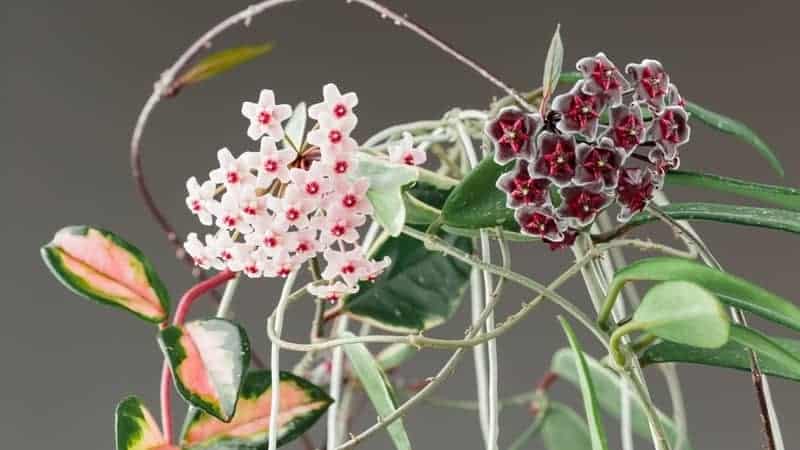
Lots of us are familiar with the classic hoya carnosa, or wax plant. They have thick, waxy leaves and are typically climbers, but they can trail as well!
However, since wax plants are known for their beautiful flowers, they need to sit in a bright spot. If kept in low light, your hoya carnosa will not flower. And if it does start budding, don’t move it or the flowers will die off.
Thankfully, less is more when it comes to watering wax plants. They can store water in their thick stems, so let the soil dry out between watering.



